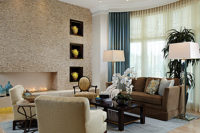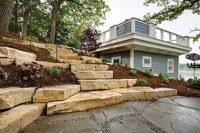“The design goal for the cabin was to create something truly unique in the middle of the forest,” said Hörning, explaining that the structure sits on his own property, which is in the Rhône-Alps region of France. “My younger brother, Tobias Hörning, who served as the architect on the project, and I wanted to design a small simple structure that was half square and half a circle combined. We thought the contrast between the two would be an interesting concept. We found it amusing that the structure takes on the form of a slice of cake.
“It also needed to have the aura of a peaceful place where one retreats to — almost like a church or meditation room,” the stonemason went on to say. “For example, the niche on the interior north wall consists of a stone from a monastery ruin. The glass stones, which are transparent on the outside and ruby on the inside, represent a ‘plus’ symbol of positivity.”
Moreover, the design objective entailed making the stone cabin appear as if it was sprouting from the earth. “We wanted the structure to be something that camouflages into the environment,” explained Hörning. “Therefore, the choice of location was also important to the design, as it now rests on a knoll leading to the forest.”
Sourcing local stone
Hörning’s stone cabin is comprised of 90% La Pierre Calcaire limestone — supplied by Roffat (SAS) of Puygiron, France — and 10% Pierre du Gres sandstone, which was found on the property near natural sandpits and also in the forest. “Puygiron is a town located approximately 30 minutes from Bourdeaux, where there is a stone quarry that extracts these white stones that are almost ivory in color,” said the stonemason. “These stones can also give off an intense gray-blue hue.
“The reason I chose La Pierre Calcaire limestone is that not only is it beautiful in color, but that it gives off a regal appearance,” Hörning continued. “It is easy to shape overall, as the stone is of a medium hardness. It gives you control in the shaping process without completely breaking the stone — resulting in the sharpest edges possible. What I also particularly admire about la Pierre Calcaire is that fossils and crystallized formations are common.”
The stonemason explained that he started off with approximately 65,000 pounds of stone, when selecting the blocks at the quarry. “After cutting and factoring loss from parts of the stone blocks that were not useable or acceptable, I ended up with approximately 33,000 pounds,” he said.
The overall diameter of the stone cabin spans 18 feet, and the wall is 20 inches wide. On average, the stone pieces have a size of 35 square inches a piece.
Building the structure
According to Hörning, mock-ups prior to construction were not necessary. “I used basic architectural plans,” he said. “Just like my other projects, I follow a philosophy of spontaneous development — let the ideas appear as the project progresses.
“When it comes to a specific method to stone installation, my philosophy is simple: integrate organic shapes, and place them in a geometrical order,” Hörning went on to explain. “I emphasize natural stone patterns and minimize joints — using them solely to highlight the design.”
Larger stones were used as a guide for placing the smaller ones, according to the stonemason. “One of the main objectives was to avoid square shapes and highlight the organic shaping that the stones naturally have, then press the stone down into the lime mortar and back into the wall in order not to make it visible, like in dry walling,” he said.
Among the most challenging parts of the installation was constructing the interior portion of the cabin where it becomes rounded, as it concaves inward. “As a mason, I’m accustomed to installing stone on the exterior of a structure,” said Hörning. “In this case, it was particularly difficult because I had to install on both the interior and exterior knowing I only had a width of 20 inches to work with. Another perplexing part was integrating the glass stones without interrupting the configuration of natural stones.”
In total, construction of the stone cabin was completed in about three weeks, according to the stonemason. “I consider the installation a four-step process,” he explained. “First, choosing the stone blocks at the quarry took about five hours. Secondly, I split the stones with a hydraulic stone splitter in order to obtain a straight/flat surface, which took approximately 35 hours of work. Thirdly, manually cutting the stones and selecting which were worthy for the project took about 80 hours. When it came to the physical installation, it was about a three-week process.
“The reaction to the project has been overwhelmingly positive, which is very gratifying,” Hörning went on to say. “Some of my colleagues thought of it just as a simple yet unique edifice, while others thought of it as a combination of sculpture and architecture. What I thought was particularly interesting was that while some were intrigued with the design aspect, it caused others to just simply think outside the box, which in retrospect was one of my goals for this project.”









